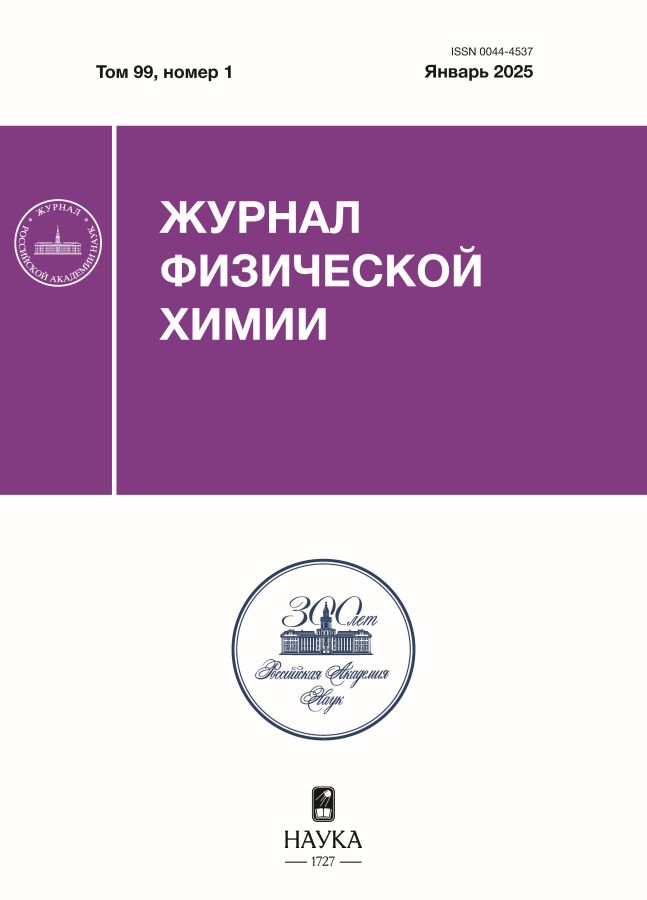Inhibitor protection of low carbon steel in the flow of sulfuric acid solution containing iron(III) sulfate
- Authors: Avdeev Y.G.1, Panova A.V.1, Andreeva T.E.1
-
Affiliations:
- Frumkin Institute of Physical Chemistry and Electrochemistry Russian Academy of Sciences
- Issue: Vol 99, No 1 (2025)
- Pages: 32-43
- Section: CHEMICAL KINETICS AND CATALYSIS
- Submitted: 01.06.2025
- Published: 17.04.2025
- URL: https://rjonco.com/0044-4537/article/view/681866
- DOI: https://doi.org/10.31857/S0044453725010033
- EDN: https://elibrary.ru/EIVIQE
- ID: 681866
Cite item
Abstract
Corrosion of low-carbon steel in the flow of H2SO4 solutions containing Fe2(SO4)3, including media with additives of corrosion inhibitors, viz. catamine AB (a mixture of quaternary ammonium salts) and IFKhAN-92 (3-substituted derivative of 1,2,3-triazole) is studied. In the discussed medium, partial reactions of anodic ionization of iron, cathodic reduction of H+ and Fe(III) cations are realized on steel. The first two reactions are characterized by kinetic control, and the latter is characterized by diffusion control. The accelerating effect of Fe2(SO4)3 on the corrosion of steel in H2SO4 solution is mainly due to the reduction of Fe(III). In contrast, in an inhibited acid, the accelerating effect of Fe(III) cations affects all partial reactions of steel. The data on corrosion of low-carbon steel in the flow of the studied media obtained by mass loss of metal samples are in satisfactory agreement with the results of the study of partial electrode reactions. The accelerating effect of Fe2(SO4)3 on steel corrosion in the flow of H2SO4 solutions, including in the presence of inhibitors, is noted. In these media, steel corrosion is determined by the convective factor, which is characteristic of diffusion-controlled processes. Unlike catamine AB, the IFKhAN-92 inhibitor ensures a significant slowdown of steel corrosion in the flow of H2SO4 solution containing Fe2(SO4)3. The reason of higher inhibitor effects of IFKhAN-92 at protection of steel in the considered media as compared to catamine AB is that it slows down partial electrode reactions of metal more substantially.
Full Text
About the authors
Ya. G. Avdeev
Frumkin Institute of Physical Chemistry and Electrochemistry Russian Academy of Sciences
Author for correspondence.
Email: avdeevavdeev@mail.ru
Russian Federation, 31-4, Leninsky prospect, 119071 Moscow
A. V. Panova
Frumkin Institute of Physical Chemistry and Electrochemistry Russian Academy of Sciences
Email: avdeevavdeev@mail.ru
Russian Federation, 31-4, Leninsky prospect, 119071 Moscow
T. E. Andreeva
Frumkin Institute of Physical Chemistry and Electrochemistry Russian Academy of Sciences
Email: avdeevavdeev@mail.ru
Russian Federation, 31-4, Leninsky prospect, 119071 Moscow
References
- Батраков В.В., Батраков В.П., Пивоварова Л.И., Соболь В.В. Коррозия конструкционных материалов. Газы и неорганические кислоты. Справочное издание. В двух книгах. Кн. 2. Неорганические кислоты. Изд. 2-е, перераб. и доп. М.: Интермет Инжиниринг, 2000. 320 с.
- Verma C., Quraishi M.A., Ebenso E.E. // Int. J. Corros. Scale Inhib. 2020. V. 9. № 4. P. 1261–1276. https://doi.org/10.17675/2305-6894-2020-9-4-5
- Глущенко В.Н., Силин М.А. Нефтепромысловая химия: Изд. в 5-ти томах. – Т. 4. Кислотная обработка скважин / Под ред. И.Т. Мищенко. М.: Интерконтакт Наука, 2010. 703 c.
- Finšgar M., Jackson J. // Corros. Sci. 2014. V. 86. P. 17–41. https://doi.org/10.1016/j.corsci.2014.04.044
- Авдеев Я.Г., Панова А.В., Андреева Т.Э. // Журн. физ. химии. 2023. Т. 97. № 5. C. 730. https://doi.org/10.31857/S0044453723050059 [Avdeev Ya.G., Panova A.V., Andreeva T.E. // Russ. J. Phys. Chem. A. 2023. V. 97. P. 1018. https://doi.org/10.1134/S0036024423050059]
- Кузнецов Ю.И., Андреев Н.Н., Маршаков А.И. // Журн. физ. химии. 2020. Т. 94. № 3. C. 381. https://doi.org/10.31857/S0044453720030152. [Kuznetsov Yu.I., Andreev N.N., Marshakov A.I. // Ibid. 2020. V. 94. № 3. P. 505. https://doi.org/10.1134/S0036024420030152]
- Richardson J.A., Abdullahi A.A. / In: Reference Module in Materials Science and Materials Engineering. Elsevier, 2017. 24 p. https://doi.org/10.1016/B978-0-12-803581-8.10517-X
- Ouarga A., Zirari T., Fashu S. et al. // J. Mater. Res. Technol. 2023. V. 26. P. 5105. https://doi.org/10.1016/j.jmrt.2023.08.198
- Авдеев Я.Г., Ненашева Т.А., Лучкин А.Ю. и др. // Хим. физика. 2024. Т. 43. № 1. P. 24. https://doi.org/10.31857/S0207401X24010033 [Avdeev Ya.G., Nenasheva T.A., Luchkin A.Yu., Marshakov A.I., Kuznetsov Yu.I. // Russ. J. Phys. Chem. B. 2024. V. 18, P. 111. https://doi.org/10.1134/S1990793124010044]
- Кеше Г. Коррозия металлов. Физико-химические принципы и актуальные проблемы. / Пер. с нем. под. ред. акад. Я.М. Колотыркина. М.: Металлургия, 1984. С. 76.
- Плетнев М.А., Решетников С.М. // Защита металлов. 2004. Т. 40. № 5. С. 513. [Pletnev M.A., Reshetnikov S.M. // Prot. Met. 2004. V. 40. P. 460. https://doi.org/10.1023/B:PROM.0000043064.20548.e0]
- Антропов Л.И. Теоретическая электрохимия. М.: Высш. школа, 1965. С. 348.
- Bockris J.O’M., Drazic D., Despic A.R. // Electrochim. Acta. 1961. V. 4. № 2–4. P. 325. https://doi.org/10.1016/0013-4686(61)80026-1
- Florianovich G.M., Sokolova L.A., Kolotyrkin Ya.M. // Electrochim. Acta. 1967. V. 12. № 7. P. 879. https://doi.org/10.1016/0013-4686(67)80124-5
- Решетников С.М. Ингибиторы кислотной коррозии металлов. Л.: Химия, 1986. 144 с.
- Плесков Ю.В., Филиновский В.Ю. Вращающийся дисковый электрод. М: Наука, 1972. 344 с.
- Du C., Tan Q., Yin G., Zhang J. / In Rotating Electrode Methods and Oxygen Reduction Electrocatalysts. Eds. W. Xing, G. Yin, J. Zhang, Elsevier B.V. All rights reserved. 2014. P. 171. https://doi.org/10.1016/B978-0-444-63278-4.00005-7
- Jia Z., Yin G., Zhang J. / In Rotating Electrode Methods and Oxygen Reduction Electrocatalysts. Eds. W. Xing, G. Yin, J. Zhang, Elsevier B.V. All rights reserved. 2014. P. 199–229. https://doi.org/10.1016/B978-0-444-63278-4.00006-9
- Краткий справочник физико-химических величин. / Под ред. К.П. Мищенко и А.А. Равделя. Л.: Химия, 1967. С. 103.
- Антропов Л.И., Погребова И.С. / Коррозия и защита от коррозии. Т. 2. (Итоги науки и техники). М.: ВИНИТИ, 1973. С. 27.
Supplementary files













